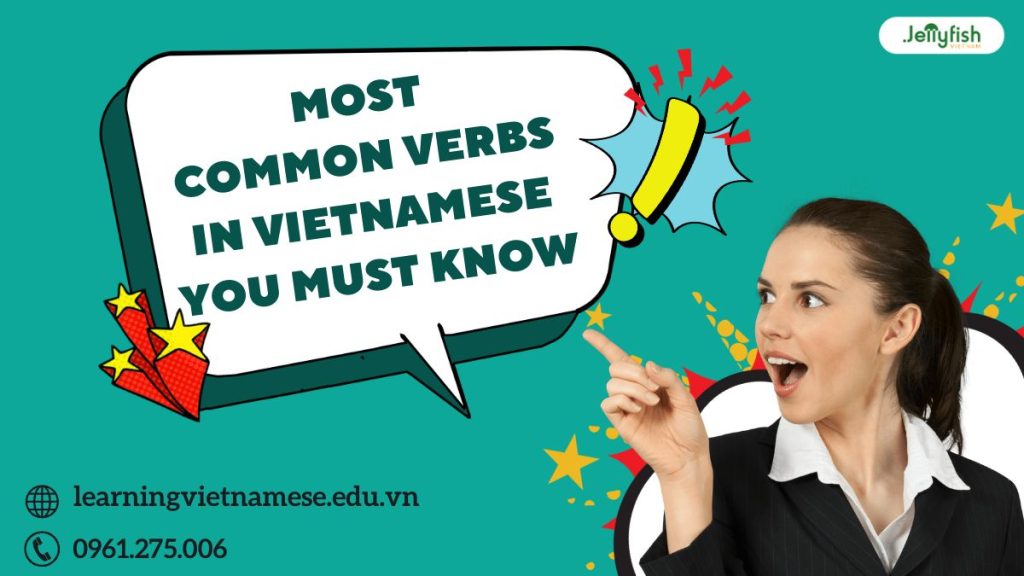When learning a new language, the best way to begin is by learning the vocabulary words that native speakers use the most. When you want to learn Vietnamese, you should begin with the most common verbs in Vietnamese. Let’s explore those verbs with Jellyfish in this article!
1. What are Vietnamese verbs?
Verbs in Vietnamese are used to talk about the actions of people and animals. They are considered as one of the indispensable parts to make up a complete sentence, even the simplest ones.
However, unlike other languages, you won’t need Vietnamese verb conjugation. That is, the verb will not change regardless of the pronoun or the tense of the sentence.
Example:
- I eat cake -> Tôi ăn bánh
- He eats cake -> Anh ấy ăn bánh
- We eat cake -> Chúng tôi ăn bánh

2. Some common verbs in Vietnamese
| Vietnamese | English | Example |
| Là (used to introduce someone’s profession, work)
Note: When you want to describe someone or something, you don’t need to use the word “is”. -> Cô ấy đẹp (She is beautiful) |
To be (Am/ Is/ Are/ Was/ Were) |
|
|
Ở (used to talk about someone’s location) |
To be in/at a location; to stay |
|
| Có | To have |
|
| Thích | To like |
|
| Làm (this word can have many meanings) | To do; to work; to make |
|
| Biết | To know | Mình không biết chỗ đó (I don’t know that place) |
| Nói | To speak/ To say | Mình biết nói một ít tiếng Nhật (I know how to speak a little Japanese) |
| Nghe | To hear/ To listen | Mình không nghe rõ (I didn’t hear clearly) |
| Hiểu | To understand | Mình không hiểu bài giảng hôm nay (I don’t understand today’s lesson) |
| Đi | To go | Tuần sau mình sẽ đi Nhật Bản (Next week I’ll go to Japan) |
| Ăn | To eat | Em trai tôi không ăn được cay (My brother can’t eat spicy things) |
| Uống | To drink | Anh ấy không thích uống rượu (He doesn’t like drinking alcohol) |
| Lấy | To take/ To get |
|
| Nghĩ | To think | Tôi nghĩ chiều nay trời sẽ mưa (I think it’s about to rain this afternoon) |
| Tới/ Đến | To come to/ To arrive | Anh ấy sẽ tới Việt Nam vào tháng sau (He’ll come to Vietnam next month) |
| Muốn | To want | Tôi muốn trở thành bác sĩ trong tương lai (I want to become a doctor in the future) |
| Mua | To buy | Mẹ tôi thích mua hoa quả ở chợ (My mother like buying fruits in the market) |
| Bán | To sell | Cửa hàng này bán quần áo cho nữ (This store sells women clothing) |
| Dùng | To take/ To use | Cái này dùng để làm gì? (This one is used to do what?) |
| Cho | To give/ To take/ To put | Anh trai cho tôi 2 vé xem phim (My brother gave me 2 movie tickets) |
| Hỏi | To ask | Anh ấy hỏi ý kiến Sếp trước khi làm việc (He asked boss’s opinion before he works) |
| Nhìn | To look at | Tôi nhìn quyển sách một lúc lâu (I looked at the book for a long time) |
| Viết | To write | Tôi đã viết thư cho bạn. (I wrote letters to my friend.) |
| Đọc | To read | Tôi thích đọc sách. (I like reading books.) |
| Mở | To open | Quán cà phê sẽ mở cửa vào 8 giờ sáng ngày mai (The coffee shop will open 8 am tomorrow.) |
| Đóng | To close | Cô ấy đóng cửa sổ. (She closes the window.) |
| Ngủ | To Sleep | Tôi ngủ lúc 10 giờ. (I sleep at 10 o’clock.) |
| Yêu | To love | Anh yêu em (I love you.) |
| Học | To study/ learn | Anh ấy đã học tiếng Việt được 6 tháng rồi (He had learned Vietnamese for 6 months.) |
See more about: All about lunar new year in Vietnam
In today’s article, Jellyfish has synthesized the simplest and most common verbs in Vietnamese along with examples that you can use in everyday conversations, especially suitable for new Vietnamese learners. Learning Vietnamese with different topics will help you easily practice and memorize vocabulary. Regular practice is the most effective, especially when you’re learning a new language!
Please fill out the registration form for Vietnamese language course consultation if you need it!
👉👉 Learning Vietnamese – Jellyfish Vietnam
✦ Hotline: 096 110 6466
✦ Head office: 13th floor, CMC building, 11 Duy Tan, Cau Giay, Hanoi
✦ Branch office: Sholega building, 275 Lach Tray, Ngo Quyen, Hai Phong
✦ Head office in Japan: 4F Westhill Building, Nishigotanda 2-24-4, Shinagawa, Tokyo, Japan



